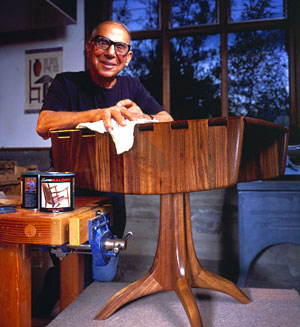 On May 21, our craft lost a revered master and beloved friend of many: Sam Maloof passed away peacefully in his home at the age of 93.
On May 21, our craft lost a revered master and beloved friend of many: Sam Maloof passed away peacefully in his home at the age of 93.
During more than 60 years of woodworking, Sam developed an organic, graceful style of furniture particularly evident in his chairs – any rocking chair with flowing lines built in the last 50 years is almost invariably described as “Maloof-inspired.”
Sam’s original low-back chairs and rockers have ended up in places like the White House and the Smithsonian museum. To me, his projects have always seemed more like an extension of nature than projects tallied up on a material list. As an outdoorsman, I look at those flowing lines and imagine that the chair could have been formed by forces of wind or rain.
And yet, his furniture is also solid and comfortable – intentionally so. Sam made sure all of his chairs provided good lower back support, holding the spindles he’d cut to his own back and sitting in the chairs he built until they felt right. No matter how beautiful the workmanship, Sam said, if the chair didn’t sit right, it was a lousy chair.
A few years ago, I had the good fortune to watch Sam build one of his trademark chairs and listen to his insights about the craft. It was an event I’ll always remember. Sam was already in his late 80s then, but still working six days a week at the craft he loved. Despite such honors as being the first designer ever to receive a MacArthur “genius” grant award, Sam preferred to think of himself as a woodworker, not an artist.
It was part of his gentle, down-to-earth personality: the same gracious personality that welcomed visitors to his home and workshop, that shared his experiences with younger woodworkers, that took a genuine interest in everyone he met.
And although Sam himself might have been self-effacing, to me it was a magical experience to watch him work. I’d never attempt some of the daring freehand cutting Sam did on the band saw (Sam himself strongly advised against it), and I noticed that he did not use measured drawings, either. Instead, Sam saw his furniture as almost living things, inspired by a higher power than himself and made “real by human hands and simple tools.”
These are noble goals worth adopting in our own projects and approach to our work, don’t you think?
Woodworking owes a great debt to you, Sam. You will be dearly missed.
Rob Johnstone, Woodworker’s Journal






